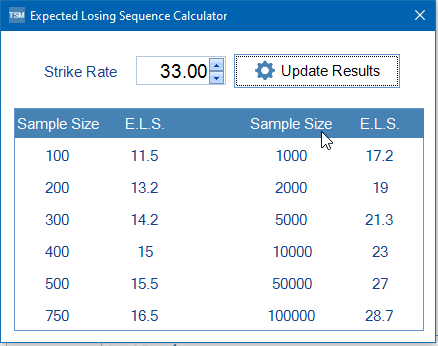Expected Losing Sequence - E.L.S.
The Expected Losing Sequence Calculator can be used to calculate our start bank and start stake and ensure that we avoid bankruptcy.
Both TSM V8 Desktop and the TSMapp (Web Based Version) have a E.L.S. Calculator included. The screenshot below is taken from TSM V8 Desktop.

The Expected Losing Sequence can be used to calculate our start bank and start stake and ensure that we avoid bankruptcy.
For instance, if you know your Expected Losing Sequence is 10 then your start bank needs to be able to handle this losing run and more !
Using a Level Stakes Staking Plan you might want a start bank of 2 x E.L.S. So if our E.L.S. was 10 then the start bank would need to be 2 x 10. On this occasion the start bank would need to be 20x our start stake. Assuming a start stake of £10 – you would need a start bank of £200 to be able to deal with the Expected Losing Sequence.
Some people will go even further and virtually eliminate the chance of bankruptcy by using a start bank of 3 or 4 x E.L.S.
The equation used to calculate the Expected Losing Sequence is:
Log(n)/-log(1-SR)= E.L.S.
If you want to have a play around yourself you can use Microsoft Excel and copy paste this formula :
| =LN(n)/-LN((1-(SR/100))) |
n = number of bets SR = strike rate as a percentage |
